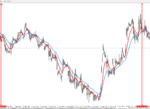I have been making profits consistently with success ratio of about 80 to 90%. and honestly i have been able to double my demo account in about one month's time.
but the catch is , when i make a loss trade , which is my signal for reverse trade, the quantum of loss is about 2.5 times of each successful trade.
If you can really sustain that over the long term, over clearly statistically significant numbers of trades, then it's a very good method.
I have one friend whose regular trading system has a stop-loss twice the size of its take-profit target, and she's been successful with it for
years.
Many people are more familiar and comfortable with methods that have a higher reward-to-risk ratio and a lower success-rate, but that doesn't make your figures any less productive or profitable.
If you can consistently win 8 trades out of 10, and lose the other two for 2.5 times as much money, you're still effectively gaining 3 trades net, out of every 10 trades. The potential difficulty is that if you win only 7 trades and lose 3 (which is an only marginally different outcome), you're
losing money instead of gaining it (7 - 7.5 = -0.5).
So, you have to be
very confident that you do, reliably, win 8 trades out of 10. If you have even an only "slightly bad run" (which everyone does, at times), it will be difficult for you to tell whether it's just a bad run of a viable system, or it's stopped working for some reason. It's easy to lose confidence, that way, and psychologically difficult.
Also, be aware that the number of trades required, to prove statistical significance, is in exponentially inverse proportion to the disparity between the actual strike-rate and 50/50. Methods which involve a very high strike-rate can be problematic for this reason. It's all too easy for them to look good on demo, only to deteriorate when traded with real money. As you can see from the example I gave above, only
one result out of ten "going the other way" can
easily represent the difference between overall profit and overall loss.
Before trading like that with real money, myself, I would want to see an absolute
minimum of 300 results, and I might still be nervous, even after that.
But in principle, it may be possible to make money steadily, over the long term, in the way you describe. Just be aware, also, of the potential disadvantages to it.
Good luck!

